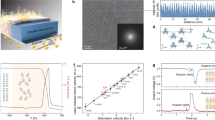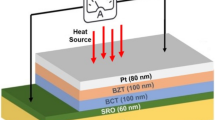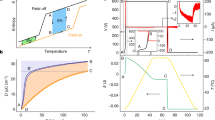Abstract
The need for efficient energy utilization is driving research into ways to harvest ubiquitous waste heat. Here, we explore pyroelectric energy conversion from low-grade thermal sources that exploits strong field- and temperature-induced polarization susceptibilities in the relaxor ferroelectric 0.68Pb(Mg1/3Nb2/3)O3–0.32PbTiO3. Electric-field-driven enhancement of the pyroelectric response (as large as −550 μC m−2 K−1) and suppression of the dielectric response (by 72%) yield substantial figures of merit for pyroelectric energy conversion. Field- and temperature-dependent pyroelectric measurements highlight the role of polarization rotation and field-induced polarization in mediating these effects. Solid-state, thin-film devices that convert low-grade heat into electrical energy are demonstrated using pyroelectric Ericsson cycles, and optimized to yield maximum energy density, power density and efficiency of 1.06 J cm−3, 526 W cm−3 and 19% of Carnot, respectively; the highest values reported to date and equivalent to the performance of a thermoelectric with an effective ZT ≈ 1.16 for a temperature change of 10 K. Our findings suggest that pyroelectric devices may be competitive with thermoelectric devices for low-grade thermal harvesting.
This is a preview of subscription content, access via your institution
Access options
Access Nature and 54 other Nature Portfolio journals
Get Nature+, our best-value online-access subscription
$29.99 / 30 days
cancel any time
Subscribe to this journal
Receive 12 print issues and online access
$259.00 per year
only $21.58 per issue
Buy this article
- Purchase on Springer Link
- Instant access to full article PDF
Prices may be subject to local taxes which are calculated during checkout




Similar content being viewed by others
References
Estimated U.S. Energy Consumption in 2016 (Livermore Lawrence National Laboratory and Department of Energy, 2017).
Ball, P. Computer engineering: Feeling the heat. Nature 492, 174–176 (2012).
Bell, L. E. Cooling, heating, generating power, and recovering waste heat with thermoelectric systems. Science 321, 1457–1461 (2008).
Vining, C. B. An inconvenient truth about thermoelectrics. Nat. Mater. 8, 83–85 (2009).
Tritt, T. M. Recent Trends in Thermoelectric Materials, Semiconductors and Semimetals. Part Two (Academic Press, San Diego, 2000).
Straub, A. P., Yip, N. Y., Lin, S., Lee, J. & Elimelech, M. Harvesting low-grade heat energy using thermo-osmotic vapour transport through nanoporous membranes. Nat. Energy. 1, 16090 (2016).
Lee, S. W. et al. An electrochemical system for efficiently harvesting low-grade heat energy. Nat. Commun. 5, 3942 (2014).
Childress, J. D. Application of a ferroelectric material in an energy conversion device. J. Appl. Phys. 33, 1793–1798 (1962).
Clingman, W. H. & Moore, R. G. Application of ferroelectricity to energy conversion processes. J. Appl. Phys. 32, 675–681 (1961).
Drummond, J. E. Dielectric power conversion. in Proc. 10th Annual Intersociety Energy Conversion and Engineering Conference, 569–575 (IEEE, New York, 1975).
Olsen, R. B. Ferroelectric conversion of heat to electrical energy - a demonstration. J. Energy 6, 91–95 (1982).
McKinley, I. M., Kandilian, R. & Pilon, L. Waste heat energy harvesting using the Olsen cycle on 0.945Pb(Zn1/3Nb2/3)O3–0.055PbTiO3 single crystals. Smart Mater. Struct. 21, 035015 (2012).
Navid, A. & Pilon, L. Pyroelectric energy harvesting using Olsen cycles in purified and porous poly(vinylidene fluoride-trifluoroethylene) [P(VDF-TrFE)] thin films. Smart Mater. Struct. 20, 025012 (2011).
Lee, F. Y., Jo, H. R., Lynch, C. S. & Pilon, L. Pyroelectric energy conversion using PLZT ceramics and the ferroelectric-ergodic relaxor phase transition. Smart Mater. Struct. 22, 025038 (2013).
Sebald, G., Pruvost, S. & Guyomar, D. Energy harvesting based on Ericsson pyroelectric cycles in a relaxor ferroelectric ceramic. Smart Mater. Struct. 17, 015012 (2007).
Bhatia, B. et al. High power density pyroelectric energy conversion in nanometer-thick BaTiO3 films. Nanoscale Microsc. Thermophys. Eng. 20, 137–146 (2016).
Olsen, R. B., Bruno, D. A. & Briscoe, J. M. Pyroelectric conversion cycles. J. Appl. Phys. 58, 4709–4716 (1985).
Sebald, G. et al. Electrocaloric and pyroelectric properties of 0.75Pb(Mg1/3Nb2/3)O3–0.25PbTiO3 single crystals. J. Appl. Phys. 100, 124112 (2006).
Karthik, J. & Martin, L. W. Pyroelectric properties of polydomain epitaxial Pb(Zr1−x,Tix)O3 thin films. Phys. Rev. B 84, 024102 (2011).
Mangalam, R. V. K., Agar, J. C., Damodaran, A. R., Karthik, J. & Martin, L. W. Improved pyroelectric figures of merit in compositionally graded PbZr1−xTixO3 thin films. ACS Appl. Mater. Interfaces 5, 13235–13241 (2013).
Choi, S. W., Shrout, T. R., Jang, S. J. & Bhalla, A. S. Morphotropic phase boundary in Pb (Mg1/3Nb2/3)O3–PbTiO3 system. Mater. Lett. 8, 253–255 (1989).
Noheda, B., Cox, D. E., Shirane, G., Gao, J. & Ye, Z.-J. Phase diagram of the ferroelectric relaxor (1-x)PbMg1/3Nb2/3O3-xPbTiO3. Phys. Rev. B 66, 054104 (2002).
McLaughlin, E. A., Liu, T. & Lynch, C. S. Relaxor ferroelectric PMN–32%PT crystals under stress and electric field loading: I-32 mode measurements. Acta Mater. 52, 3849–3857 (2004).
Davis, M., Damjanovic, D. & Setter, N. Electric-field-, temperature-, and stress-induced phase transitions in relaxor ferroelectric single crystals. Phys. Rev. B 73, 1–16 (2006).
Fu, H. & Cohen, R. Polarization rotation mechanism for ultrahigh electromechanical response in single-crystal piezoelectrics. Nature 403, 281–283 (2000).
Kutnjak, Z., Petzelt, J. & Blinc, R. The giant electromechanical response in ferroelectric relaxors as a critical phenomenon. Nature 441, 956–959 (2006).
Kim, Y. J., Choi, S. W. & Bhalla, A. S. Dielectric, pyroelectric properties, and morphotropic phase boundary in La-doped (1−x)Pb(Mg1/3Ta2/3)–xPbTiO3 solid solution ceramics. Ferroelectrics 173, 87–96 (1995).
Taylor, D. J., Damjanovic, D. & Bhalla, A. S. Pyroelectric and dielectric properties of pmn-based ceramics under dc bias. Ferroelectrics 118, 143–155 (1991).
Raevskaya, S. I. et al. Critical nature of the giant field-induced pyroelectric response in single crystals. Appl. Phys. Lett. 93, 042903 (2008).
Smirnova, E. P. & Sotnikov, A. V. Pyroelectric and elastic properties of lead magnesium niobate- and barium titanate-based solid solutions near a phase transition. Phys. Solid State 48, 102–105 (2006).
Smirnova, E. P., Aleksandrov, S. E., Sotnikov, K. A., Kapralov, A. A. & Sotnikov, A. V. Pyroelectric effect in lead-magnoniobate-based solid solutions. Phys. Solid State 45, 1305–1309 (2003).
Pandya, S. et al. Direct measurement of pyroelectric and electrocaloric effects in thin films. Phys. Rev. Appl. 7, 034025 (2017).
Maria, J.-P., Hackenberger, W. & Trolier-McKinstry, S. Phase development and electrical property analysis of pulsed laser deposited Pb(Mg1/3Nb2/3)O3–PbTiO3 (70/30) epitaxial thin films. J. Appl. Phys. 84, 5147–5154 (1998).
Colla, E. V., Yushin, N. K. & Viehland, D. Dielectric properties of (PMN)(1−x)(PT)x single crystals for various electrical and thermal histories. J. Appl. Phys. 83, 3298–3304 (1998).
Ang, C. & Yu, Z. Dc electric-field dependence of the dielectric constant in polar dielectrics: multipolarization mechanism model. Phys. Rev. B 69, 174109 (2004).
Li, Z., Xu, Z., Yao, X. & Cheng, Z. Y. Phase transition and phase stability in [110]-, [001]-, and [111]-oriented 0.68Pb(Mg1/3Nb2/3)O3–0.32PbTiO3 single crystal under electric field. J. Appl. Phys. 104, 024112 (2008).
Bai, F. et al. X-ray and neutron diffraction investigations of the structural phase transformation sequence under electric field in 0.7Pb(Mg1∕3Nb2∕3)–0.3PbTiO3 crystal. J. Appl. Phys. 96, 1620–1627 (2004).
Xu, G., Zhong, Z., Bing, Y., Ye, Z.-G. & Shirane, G. Electric-field-induced redistribution of polar nano-regions in a relaxor ferroelectric. Nat. Mater. 5, 134–140 (2006).
Takenaka, H., Grinberg, I., Liu, S. & Rappe, A. M. Slush-like polar structures in single-crystal relaxors. Nature 546, 391–395 (2017).
Olsen, R. B. & Brown, D. D. High efficiency direct conversion of heat to electrical energy-related pyroelectric measurements. Ferroelectrics 40, 17–27 (1982).
McKinley, I. M., Lee, F. Y. & Pilon, L. A novel thermomechanical energy conversion cycle. Appl. Energy 126, 78–89 (2014).
Uršič, H. et al. Specific heat capacity and thermal conductivity of the electrocaloric (1−x)Pb(Mg1/3Nb2/3O3–xPbTiO3 ceramics between room temperature and 300 °C. J. Microelectron. Electron. C 45, 260–265 (2015).
Novak, N., Cordoyiannis, G. & Kutnjak, Z. Dielectric and heat capacity study of (Pb(Mg1/3Nb2/3)O3)0.74–(PbTiO3)0.26 ferroelectric relaxor near the cubic–tetragonal–rhombohedral triple point. Ferroelectrics 428, 43–48 (2012).
Zhu, H., Pruvost, S., Guyomar, D. & Khodayari, A. Thermal energy harvesting from Pb(Zn1/3Nb2/3)0.955Ti0.045O3 single crystals phase transitions. J. Appl. Phys. 106, 124102 (2009).
Khodayari, A., Pruvost, S., Sebald, G., Guyomar, D. & Mohammadi, S. Nonlinear pyroelectric energy harvesting from relaxor single crystals. IEEE Trans. Ultrason. Ferroelectr. Freq. Control 56, 693–698 (2009).
Kandilian, R., Navid, A. & Pilon, L. The pyroelectric energy harvesting capabilities of PMN–PT near the morphotropic phase boundary. Smart Mater. Struct. 20, 055020 (2011).
Lee, F. Y., Navid, A. & Pilon, L. Pyroelectric waste heat energy harvesting using heat conduction. Appl. Therm. Eng. 37, 30–37 (2012).
Nguyen, H., Navid, A. & Pilon, L. Pyroelectric energy converter using co-polymer P(VDF-TrFE) and Olsen cycle for waste heat energy harvesting. Appl. Therm. Eng. 30, 2127–2137 (2010).
Cha, G. & Ju, Y. S. Pyroelectric energy harvesting using liquid-based switchable thermal interfaces. Sens. Actuat. A 189, 100–107 (2013).
Cahill, D. G. Thermal conductivity measurement from 30 to 750 K: the 3ω method. Rev. Sci. Instrum. 61, 802 (1990).
Acknowledgements
S.P. acknowledges support from the Army Research Office under grant W911NF-14-1-0104. J.W. acknowledges support from a UC Berkeley Graduate Fellowship. J.K. acknowledges support from the US Department of Energy, Office of Science, Office of Basic Energy Sciences through grant no. DE-SC-0012375 for development of the relaxor materials. R.G. acknowledges support from the National Science Foundation under grant OISE-1545907. A.D. acknowledges support from the National Science Foundation under grant DMR-1708615. L.W.M. acknowledges support of the US Department of Energy, Office of Science, Office of Basic Energy Sciences, Materials Sciences and Engineering Division under contract no. DE-AC02-05-CH11231: Materials Project programme KC23MP for development of advanced functional materials.
Author information
Authors and Affiliations
Contributions
S.P. and L.W.M. conceived the central concepts and designed the experiments. J.K. synthesized the materials. S.P. completed the electrical studies. J.K. and R.G. completed the structural characterization of the materials. S.P. and J.W. completed the thermal characterization and implemented the energy conversion cycles. S.P. conducted additional thermal–electrical studies that contributed to the understanding of the data. J.W. and C.D. contributed to the development of both the analytical and finite-element-based heat transport models. J.W., J.K. and A.D. contributed to analysis, discussions and understanding of the data and the development of the manuscript. S.P. and L.W.M. wrote the core of the manuscript. All authors discussed the results and implications of the work and commented on the manuscript at all stages.
Corresponding author
Ethics declarations
Competing interests
The authors declare no competing interests.
Additional information
Publisher’s note: Springer Nature remains neutral with regard to jurisdictional claims in published maps and institutional affiliations.
Supplementary information
Supplementary Information
Supplementary Figures 1–9, Supplementary Table 1, Supplementary References 1–12.
Rights and permissions
About this article
Cite this article
Pandya, S., Wilbur, J., Kim, J. et al. Pyroelectric energy conversion with large energy and power density in relaxor ferroelectric thin films. Nature Mater 17, 432–438 (2018). https://doi.org/10.1038/s41563-018-0059-8
Received:
Accepted:
Published:
Issue Date:
DOI: https://doi.org/10.1038/s41563-018-0059-8
This article is cited by
-
Low thermal conductivity and high durability porous thermal insulation coating via room–temperature spray coating process
Journal of the Korean Ceramic Society (2024)
-
Giant polarization ripple in transverse pyroelectricity
Nature Communications (2023)
-
Improved pyroelectric effect in PVDF/BaTiO3 composite flexible films mediated by enhanced β – PVDF phase formation
Journal of Polymer Research (2023)
-
Large harvested energy with non-linear pyroelectric modules
Nature (2022)
-
Pyroelectricity gain in multilayers
Nature Energy (2022)



